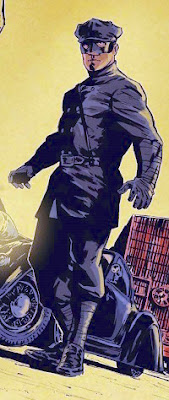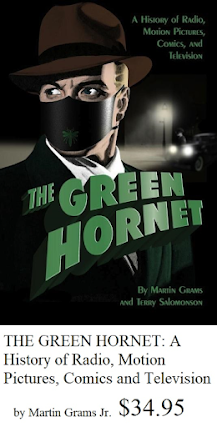By Martin Grams, Jr.
Great controversy has been discussed among fanboys regarding Kato’s nationality, the faithful sidekick of The Green Hornet, who rendered valuable assistance in the crusade against crime. On the radio program, Kato usually remained in the shadows should a situation become dangerous, to apply assistance when the risk was too dangerous for The Green Hornet to act alone (such as shooting the lights out or remaining behind the wheel of the Black Beauty to speed away and make haste an escape).
On television, Kato played a larger role as he stood alongside The Green Hornet to demonstrate muscle against henchmen under employment. George W. Trendle, producer of the radio program, once wrote a letter to William Dozier with a complaint about Kato’s role on the television program, emphasizing how villains would be able to assume Britt Reid was The Green Hornet because few had an Asian sidekick and chauffeur… leading Dozier to explain to Trendle that television viewers did not apply such logic because, well, it was a television program.
His manner and appearance are those of a wealthy clubman. Mounted heads of big game, silver trophies, and various pictures in the place, show him to have been an outstanding college athlete and later something of a big game hunter. Kato himself was something of a trophy, brought back from a trip to the Orient by Britt Reid. Kato seems to serve Britt in every capacity; valet, cook, chauffeur and handyman.
Kato’s ethnicity, however, was put in question a number of times throughout the years — supposedly his country of origin changed during the turbulent years of the Second World War. Rumor has it that the day after the bombing of Pearl Harbor, Kato’s nationality changed from Japanese to Filipino. As it turns out, the myth is false. Kato was Japanese beginning with the premiere broadcast of 1936. But truth be known, he was Filipino before the U.S. entry into the war.
On January 9, 1937, Japan’s army took control and conquered Shanghai, China. Newspapers reported the country’s negative image throughout the year (especially in July of 1937) when the Second Sino-Japanese War and the Marco Polo Bridge Incident led to the Japanese occupation of Beijing and Tianjin.
KATO: Mr. Britt, I am unhappy about the war ...
BRITT: I know, Kato.
KATO: As long as war things are sent to the East, it will keep on.
BRITT: That’s the curse of civilization, Kato! Those who profit by it, sustain war.
In the script for “War on the Waterfront” (July 18, 1939), the announcer comments, “That evening in his apartment, Britt Reid showed a copy of the photograph to Kato, his Filipino valet and the only living man to know that his employer was really the Green Hornet!” The word “Filipino” was scratched out and the word “faithful” substituted. This is the earliest indication found that script writer Fran Striker chose to change Kato’s race without explanation and hope the radio audience would not question it.
Beginning with the episode “Man Wanted — For What?” (June 21, 1941), Kato was clearly referred to as Filipino, months before the U.S. entry into the war escalating overseas. The Philippine Islands were ceded to the United States in 1898 and became a self-governing commonwealth in 1935. With the Japanese occupation of the islands during the war, it seemed logical to make Kato a Filipino when given the choice of another race.
Throughout November and December 1941, no reference was made about Kato’s nationality. Striker’s scripts for The Green Hornetwere written weeks in advance, so it wasn’t until the broadcast of January 10, 1942, that Kato was referred to again as a Filipino. Concern after the attack was obvious since all the broadcasts from January 10 to March 7 not only referred to Kato as a Filipino, but Striker did so numerous times in each script.
Prior to the war, questioning Kato’s country of origin remained a constant problem regarding marketing. After mailing out a number of photos (minimum of 11 known to exist) to the 23 current radio stations for inclusion in local papers, Charles Hicks, manager of the sales promotion department at King-Trendle, explained in a letter dated October 20, 1938: “We hesitate to take new views of Kato because he is a most difficult subject to photograph, particularly for the one reason that unless you get the right angle, there is danger of making him look like a Chinese, which of course to a Jap is next to hari-kari. For this reason, it was determined to take the photograph of Kato encased in the automobile.”
One photo of Kato in the car wearing a chauffeur’s cap and puttees was definitely used by N.W. Ayer for Detroit Creamery publicity. While there was never a problem with the general public accepting Kato as a Japanese chauffeur, the same photo was reprinted in late 1938 and only at that time did the photo premium start to cause a bit of negative feedback.
It was decided to leave off the Japanese characters on the photo because of (according to an inter-office memo dated February 16, 1939) one or two complaints that the Japanese characters might imply a “code.” At least one Michigan visitor from California, where “Japs” were watched very closely, reported his concern to station WXYZ.
For the radio program, actor Tokataro Hayashi was the first to play the role of Kato (beginning in January of 1936). His talent contract assured him $25 per week to play the role, “whether by radio or visual broadcasting and for as many performances as are necessary.”
As of September 8, 1938, his salary went up an extra $5 per week. Hayashi was renamed by Jewell as Toyo, and he is sometimes credited on paper as Raymond Hayashi and/or Raymond Toyo. Sometime in 1942 (the exact date remains unknown), Raymond Toyo Hayashi came upon a problem that offered no solution. Because of the war, the U.S. government sent official notice that Toyo was to be sent back to Japan. Since Dick Osgood was broadcasting a series called March of Victory for the Hi-Speed Gas Stations, and a number of scripts had to be cleared through six departments in Washington, the little Japanese believed that Osgood might have an “in” with the government.
But it was not so and Osgood could do nothing to aid Toyo. Trendle had no influence with members of Congress to have the notice served on Toyo waived. According to Osgood, the Japanese actor disappeared, “presumably to a concentration camp in the west.” No one at WXYZ ever saw Toyo again. At least, that was what Osgood reported in his book, W.Y.X.I.E. Wonderland, but a few years ago it was discovered that Tokataro Hayashi went to the West Coast and became a servant for a wealthy family, ultimately getting married and having a family of his own which included children and grandchildren.
Replacing Toyo in 1942 was staff member Rollon Parker. Parker was hired as an actor and announcer in the mid-’30s, and would deliver commercials when called upon. Parker also doubled in the role of the newsboy during the closing of each Green Hornet broadcast; his earliest known role as the newsboy was the broadcast of April 26, 1938.
When Universal Studios began production of the 1940 cliffhanger serial, The Green Hornet and in 1941, The Green Hornet Strikes Again, the studio voted to make Kato a Korean to avoid any possibility of complaints. (Oddly, an article in the January 1940 issue of Radio Variety incorrectly stated Kato was Korean on the radio program).
While Kato’s nationality was never referenced on the television program of the 1960s, paperwork in William Dozier’s archive stated Kato was Korean on the program, but indirect reference in press releases and publicity for the series claimed he was Chinese.
About the Author
Martin Grams Jr. is the author and co-author of numerous books about old-time radio and retro television. Winner of numerous awards in the Best Book categories, author of more than 100 magazine articles and co-author of the up-coming THE LONE RANGER: THE EARLY YEARS, 1933-1937.




















No comments:
Post a Comment
Thank you for your comment.